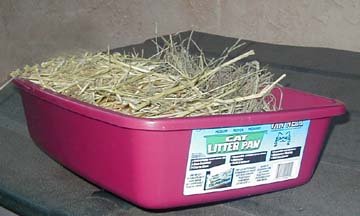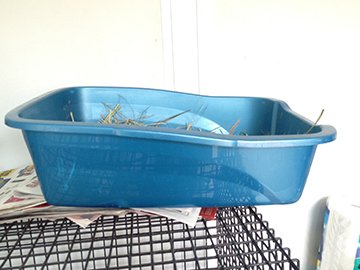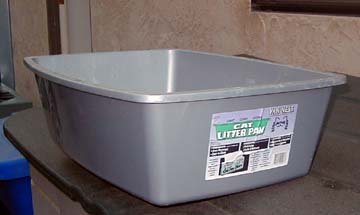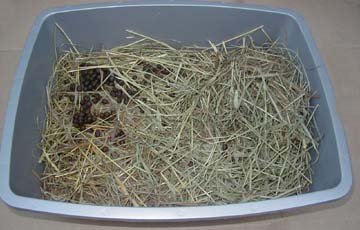Litter Box Setup
Did you know rabbits can be litter box trained? They can! In fact, it is very common for house rabbits to develop strong litter box habits when they have easy, consistent access to a litter box filled with comfortable, absorbent bedding and fresh grass hay. Some factors in your rabbit’s health and environment can affect their litter box use, such as whether they are spayed or neutered, getting used to a new home, sharing space with another rabbit, changes in their mobility, etc.
Not sure how to set up a rabbit-friendly litter box? Learn the basics below, and help your rabbit(s) on their way to successful litter box training.
Plastic Cat-Size Litter Box
While some brands make litter boxes advertised for rabbits, they are often far too small. Basic plastic cat litter boxes work best for rabbits.
Cat litter boxes come in many sizes and can be found at our SDHRS Online Store. We recommend sticking to the medium, large, or giant litter pans for most bunnies. Choosing the size of the litter box will depend on the size of your rabbit(s) and it’s better to size up rather than size down.
If you have a pair of rabbits sharing the same litter box, the ideal set up requires a larger litter box or multiple litter boxes to keep them well supplied with hay and fresh litter. If you are unable to find a large enough litter box, a great alternative for larger rabbits or pairs is a “cement mixing tub” from Home Depot.
Litter Bedding
We recommend using a paper-based litter, such as Carefresh. Carefresh is rabbit-safe and environmentally friendly. You may also use other rabbit-safe litters such as Yesterday’s News, wood stove pellets (with no accelerant or other chemicals), Feline Pine, or Critter Country. Carefresh is available at our SDHRS Online Store.
Never use cat litter. Your rabbit(s) may ingest it when cleaning their paws, and the clay, crystals, fragrances, or other common cat litter ingredients are poisonous to rabbits. Never use pine or cedar shavings, clumping or clay litters, silica-gel crystals, corn cob, or litter/bedding with additives such as baking soda.
We recommend using CareFresh, Oxbow Pure Comfort, or a similar bedding and fresh hay to prepare your bunny’s litter box. Select a rabbit-safe paper pet bedding that does not contain any pine or cedar products, fragrances, and is also environmentally friendly. Fresh hay is the main staple of your rabbit’s diet (85 percent) and it entices your rabbit to use the litter box.
Setting Up a Litter Box
A fresh litter box with bedding and a layer of hay
Well-used box rabbit litter box
First, fill a clean box with approximately 1 inch of clean bedding, like CareFresh or Oxbow Pure Comfort, fully covering the bottom. It’s important to avoid any clay-based litter or paper bedding with additives (like baking soda).
Next, add a generous layer of hay. Each day, rabbits usually need a bundle of hay that’s the size of their body when lightly compressed. Spread some hay over the litter.
Finally, add more to the “kitchen” end of the box at least once a day until it’s time to clean the box in 2-3 days.
About 12 hours later, here is a well-used box. You can see that the rabbit has created a "bathroom" end and a "kitchen" end (the end with remaining clean hay).
Keep a Fresh Box
Change your rabbit’s litter box frequently, to ensure a clean, fresh box. This will prevent the rabbit from heading to cleaner places to eliminate. If your rabbit does not soil their box completely within a 24-hour period, simply add another large handful of hay to the "kitchen" end, to replenish their supply. Never go for more than 2-3 days before giving your rabbit a fresh litter box.
Rabbit litter boxes are easy to clean and don’t get nearly as smelly as cat litter boxes. Dump the contents into your garbage can or compost. Rabbit litter is completely biodegradable and makes excellent compost! Then spray or pour a 50/50 mixture of water and white vinegar onto the litter box. Let sit for a minute. If there is urine build-up, let the litter box soak a litter longer and use a scrubby sponge. Wipe it down with a paper towel or cloth and rinse with clean water. Do not use chemicals. Refill their litter box with bedding and fresh hay once the litter box is completely dry.
Options for Rabbits with Limited Mobility
If you have a rabbit who has a disability or is older and cannot easily access a typical litter box, special low-entry or custom-made boxes can be just the thing to help rabbits retain their litter box skills.
A Simple Cut-Down Litter Box
The easiest solution can often be just cutting-down the side of an ordinary, rectangular litter box. Be sure to cover the cut edges with cord cover, a heavy tape, or something to prevent your rabbit (s) from being cut or scraped. This allows rabbits to access the litter box more easily when they are stiff and sore or have mobility problems.
Low-Entry Cat/Dog Litter Box
Litter boxes with a lowered entry on one side are made for dogs and senior cats, but work well for disabled rabbits. These can also be supplemented with folded blankets to make ramps.
Table Top Potting Containers
These new containers work just like a low-entry litter box and have been helpful to those with older rabbits who need a lower entry to step into the box instead of hopping over a tall side. These are available to purchase at gardening stories and on Amazon. Remember, every time you shop at San Diego House Rabbit Society, you’re supporting our organization and the rabbits we serve
Low-Entry Litter Box with Ramp
Here is an example of a lowered-entry box with blankets folded to create ramps for a rabbit. This way, the rabbit doesn’t have to jump as high to clear the entryway.
In addition to modified litter box set ups, for housing setup and ideas for bunnies with disabilities and other special needs, visit the following:
https://www.specialbunny.org/bunny-rabbit-health-and-special-needs/special-needs-housing?rq=housing
http://www.disabledrabbits.com/litter-boxes.html
Disabled Rabbits Group on Facebook.
Rabbits Enjoy Their Litter Boxes
Once introduced and used to frequent fresh hay in a clean box, your rabbit(s) will grow to love it! They will nibble and munch on hay nearly 24 hours a day - important for healthy rabbit digestion - and may even burrow under it searching for the choicest bits.
After setting up your rabbit’s litter box in this manner, if you still have some problems with your rabbit using their box, try some of our litter box training tips. You can also email us at education@sandiegorabbits.org.
This rabbit loves to burrow under her hay!
Two companion rabbits sharing their litter box.
















